
Piombino is an Italian town and comune of about 35,000 inhabitants in the province of Livorno (Tuscany). It lies on the border between the Ligurian Sea and the Tyrrhenian Sea, in front of Elba Island and at the northern side of Maremma.
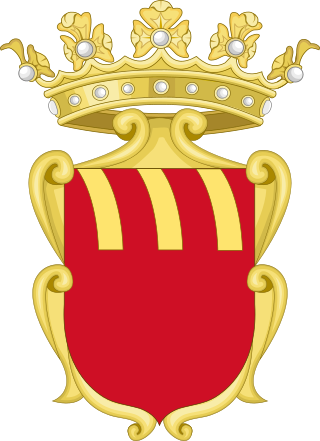
The House of Ludovisi was an Italian noble family, originating from Bologna. They had close ties with the Papacy and were influential in the Papal States. Alessandro Ludovisi became a cardinal and later Pope Gregory XV. His cardinal-nephew was Ludovico Ludovisi.

The House of Boncompagni is a princely family of the Italian nobility which settled in Bologna in around the 14th century, but was probably originally from Umbria.

The Lordship of Piombino, and after 1594 the Principality of Piombino, was a small state on the Italian peninsula centered on the town of Piombino and including part of the island of Elba. A vassal of the Kingdom of Naples associated with the State of the Presidios and a territory of the Holy Roman Empire formed from the remnants of the Republic of Pisa, it existed from 1399 to 1805, when it was merged into the Principality of Lucca and Piombino. In 1815 it was absorbed into the Grand Duchy of Tuscany.

Ippolita I Ludovisi was the Princess of Piombino, Marchioness of Populonia, Princess of Venosa and Countess of Conza, Lady di Scarlino, Populonia, Vignale, Abbadia del Fango, Suvereto, Buriano, Cerboli e Palmaiolan, and Lady princess of the Tuscan Archipelago including the islands of Elba, Montecristo, Pianosa, Gorgona, Capraia, and Isola del Giglio from 1701 until her death in 1733.
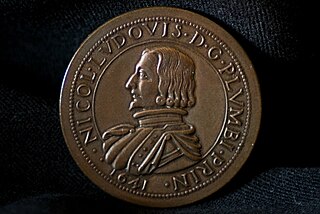
Niccolò I Ludovisi, 2nd Duke of Fiano and Zagarolo, was Prince of Piombino, Marquis of Populonia, Prince of Venosa and Count of Conza, Lord di Scarlino, Populonia, Vignale, Abbadia del Fango, Suvereto, Buriano, Cerboli e Palmaiolan, and Lord prince of the Tuscan Archipelago including the islands of Elba, Montecristo, Pianosa, Gorgona, Capraia, and Isola del Giglio from 1634 until his death.

Olimpia Aldobrandini was rich and powerfull Italian noblewoman. By birth, she was member of an old and influential Aldobrandini family of Rome, and the sole heiress to the great family fortune.

Camillo Francesco Maria Pamphili, 1st Prince of San Martino al Cimino and Valmontone was an Italian Catholic cardinal and nobleman of the Pamphili family. His name is often spelled with the final long i orthography; Pamphilj.
Gregorio II Boncompagni was an Italian nobleman and the 5th Duke of Sora. He was the grand-nephew of Pope Gregory XIII
Orazio Ludovisi was an Italian nobleman, military commander and patrician of Bologna. During his brother's reign as Pope Gregory XV, he became Commander of the Papal Armies, Roman Noble and 1st Duke of Fiano and Zagarolo.
Isabella Appiani was Princess of Piombino from 1611 until 1628. Through her father, she was a descendant of Lorenzo de' Medici.
Olimpia Ludovisi was the ruling Princess of Piombino, Marchioness of Populonia, Princess of Venosa and Countess of Conza, Lady di Scarlino, Populonia, Vignale, Abbadia del Fango, Suvereto, Buriano, Cerboli e Palmaiolan, and Lady princess of the Tuscan Archipelago including the islands of Elba, Montecristo, Pianosa, Gorgona, Capraia, and Isola del Giglio in 1700.
Maria Eleonora I Boncompagni (1686–1745) was the Princess of Piombino, Marchioness of Populonia, Princess of Venosa and Countess of Conza, Lady di Scarlino, Populonia, Vignale, Abbadia del Fango, Suvereto, Buriano, Cerboli e Palmaiolan, and Lady princess of the Tuscan Archipelago including the islands of Elba, Montecristo, Pianosa, Gorgona, Capraia, and Isola del Giglio, from 1733 until her death.

The Appiani family was an Italian noble family, originally from Al Piano or Appiano, a now disappeared toponym identified with the modern La Pieve in the comune of Ponsacco, Tuscany. They held the principality of Piombino from the early 15th century until 1628.
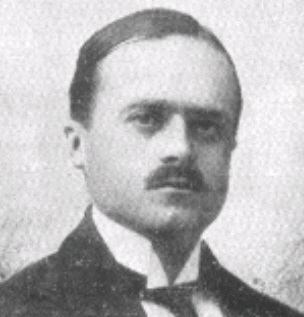
Don Francesco Antonio Maria, Prince Boncompagni-Ludovisi, Prince of Piombino, Duke of Sora, etc, was an Italian politician.

Anna Maria Arduino (1672–1700) was an Italian regent, socialite, painter and writer. She was the regent of the Principality of Piombino during the minority of her son Prince Niccolò II Ludovisi in 1699–1700.
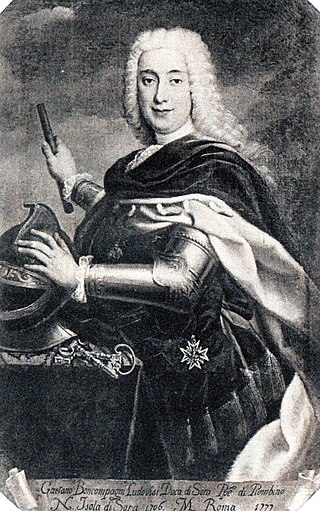
Gaetano I Boncompagni Ludovisi (1706–1777) was VII Duke of Sora and the Prince of Piombino, Marquis of Populonia, Prince of Venosa and Count of Conza, Lord di Scarlino, Populonia, Vignale, Abbadia del Fango, Suvereto, Buriano, Cerboli e Palmaiolan, and Lord prince of the Tuscan Archipelago including the islands of Elba, Montecristo, Pianosa, Gorgona, Capraia, and Isola del Giglio, from 1745 until 1777.
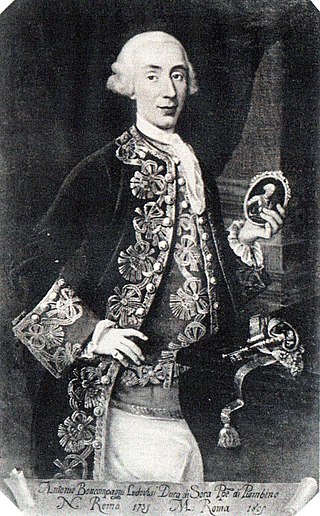
Don Antonio II Boncompagni-Ludovisi, then Prince Boncompagni-Ludovisi, was the 8th Duke of Sora, Aquino, Arce and Arpino and 9th Marquess of Vignola and the Prince of Piombino, Marquis of Populonia, Prince of Venosa and Count of Conza, Lord di Scarlino, Populonia, Vignale, Abbadia del Fango, Suvereto, Buriano, Cerboli e Palmaiolan, and Lord prince of the Tuscan Archipelago including the islands of Elba, Montecristo, Pianosa, Gorgona, Capraia, and Isola del Giglio, from 1733 until he ceded the duchy in 1796 and was deposed in the principality on 21 March 1801 and in the marquessate during the Napoleonic Wars.
Olimpia Aldobrandini, Princess of Meldola was an Italian noblewoman, known by historians as Olimpia Aldobrandini the Elder to distinguish her from her granddaughter Olimpia Aldobrandini the Younger (1623-1681).













